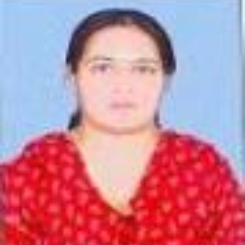
Geeta Nijhawan
Work place: Faculty of Engineering and Technology, Manav Rachna International University, Faridabad, 121003, India.
E-mail: geeta.fet@mriu.edu.in
Website:
Research Interests: Speech Synthesis, Speech Recognition, Image and Sound Processing
Biography
Dr. Geeta Nijhawan did her Ph.D. in speech signal processing , M.Tech in Electronics and Communication Engineering in 2006 and B.E (Electronics) in 1995 from Government Engineering College, Raipur (Now NIT Raipur). She has a rich experience of 15 years in
academics. She has authored three books on Electronics & Communication. Presently she is Associate Professor in ECE department, Faculty of Engineering and Technology, Manav Rachna International University, Faridabad.
Author Articles
Design of Microwave Antenna for Hyperthermia System
DOI: https://doi.org/10.5815/ijwmt.2016.04.04, Pub. Date: 8 Jul. 2016
Hyperthermia is a thermal therapy for cancer treatment in which body temperature is exposed to elevated temperature of 40-42oC. Microwave ablation has a potential to be sensitive to changes in the dielectric tissue parameters which results in damaging abnormal tissues. In order to produce heat in the focused area microwave signals are adjusted in time, frequency and strength. The commonly used frequencies in microwave imaging systems are 415MHZ and 2.45GHZ which are transmitted from the antennas enclosing the relevant body part. This paper presents a highly efficient E-Shape micro strip patch microwave antenna operated at 2.45 GHz which can be used in various applicators for hyperthermia treatment system. The simulation is done on IE3D simulator. The results are compared at two feeding points 1 and 2 for the frequency 2.45GHZ. It gives return loss of -19.3dB, bandwidth of 6.2dB and the antenna efficiency of 92% for feeding point 1 which proves to be highly effective in communication.
[...] Read more.Real Time Speaker Recognition System for Hindi Words
DOI: https://doi.org/10.5815/ijieeb.2014.02.04, Pub. Date: 8 Apr. 2014
Real time speaker recognition is needed for various voice controlled applications. Background noise influences the overall efficiency of speaker recognition system and is still considered a challenge in Speaker Recognition System (SRS). In this paper MFCC feature is used along with VQLBG algorithm for designing SRS. A new approach for designing a Voice Activity Detector (VAD) has been proposed which can discriminate between silence and voice activity and this can significantly improve the performance of SRS under noisy conditions. MFCC feature is extracted from the input speech and then vector quantization of the extracted MFCC features is done using VQLBG algorithm. Speaker identification is done by comparing the features of a newly recorded voice with the database under a specific threshold using Euclidean distance approach. The entire processing is done using MATLAB tool.The experimental result shows that the proposed method gives good results.
[...] Read more.A New Design Approach for Speaker Recognition Using MFCC and VAD
DOI: https://doi.org/10.5815/ijigsp.2013.09.07, Pub. Date: 8 Jul. 2013
This paper presents a new approach for designing a speaker recognition system based on mel frequency cepstral coefficients (MFCCs) and voice activity detector (VAD). VAD has been employed to suppress the background noise and distinguish between silence and voice activity. MFCCs were extracted from the detected voice sample and are compared with the database for recognition of the speaker. A new criteria for detection is proposed which gives very good performance in noisy environment.
[...] Read more.Other Articles
Subscribe to receive issue release notifications and newsletters from MECS Press journals